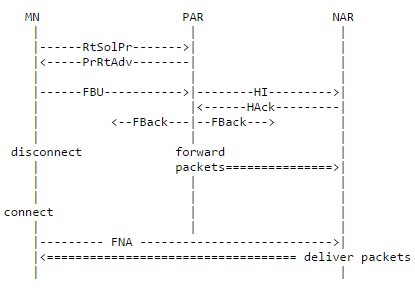Despite the advances brought by MIPv6 concerning mobility management, thanks to native IPv6 functions such as auto-configuration mechanism or neighbor discovery, MIPv6 shows some limits. Indeed, those limitations are mainly related to the high-speed mobility (internet incar) or very high-speed mobility (in bullet trains) or real-time applications.
Furthermore the well-known Triangle Routing is responsible of latency. Indeed according to this scheme, every packet must go through the Home Agent before to reach the correspondent node. We are talking about Route Optimization.
RPP
A route optimization for MIPv6 might be the Return Routing Procedure. It allows the MN to send a BU to its CNs that also implements MIPv6. While using this procedure, there is no more Triangle Routing, all packets are directly routed between the MN and its CNs without passing through the HA.

The CN behaves like a HA but the MN has to prove to CN that it owns both HoA and CoA. It can do this by receiving packets on the HoA and CoA.
By exchanging of HoTi (Home Address Test init) and HoT (Home Address Test) messages MN can prove that is able to emit and receive packets from/to its HoA. These messages are sent through the IPv6 tunnel established with the HA.
Then by exchanging of CoTi (Care-of Address Test init) ang CoT (Care-of Address Test) messages, MN proves that is able to emit and receive packets from/to its CoA. These messages are sent directly between the MN and the CN.
Finally the standard process goes on normally, except that packets are sent using the Routing Header Type 2 and the Home Address Option. If the HA was directly used in the IPv6 header, messages cold be dropped by the MN’s and CN’s Access Router.
FMIPv6
First limitations are mainly due to handover latency (intercell handover: UK or intercell handoff: US) that can lead to losses of packets perceptible by the user or else a connection interruption so a communication interruption. We call handover the process that allows the MN to change its access point or Access Router.
There are three main periods due to handover:
Handover period at the layer 2
Network change period and acquisition of a new CoA
Binding Update period
RFC 4068 defines 2 schemes of Fast Handover for MIPv6, the predictive and reactive one. We will focus here on the first one because it has shorter latency than the reactive one.

The MN sends a Router Solicitation for Proxy Advertisement (RtSolPr) to the current router or Previous Access Router (PAR) to get the list of its neighbors. The PAR sends this list back which contains neighbors’ IP.
After that, when the MN needs to change of router, it sends a Fast Binding Update (FBU) message to its PAR. The FBU contains the new CoA of the MN. The PAR immediately informs the New Access Router (NAR) by sending a Handover Initiate (HI) message with the new address.
The NAR sends back the Handover Acknowledgement (Hack). The PAR then accepts and sends back a Fast Binding Acknowledgement (FBack) message.
Finally the PAR forwards packets to the NAR that stocks it waiting for the final connection of the MN to its network. The MN accomplishes this connection by sending a Fast Neighbor Announcement (FNA) to the NAR to let it know about its connection, so the NAR might be able to deliver packets.
The very last operation that the MN has to do is to send a BU to its CNs.
HMIPv6
FMIPv6 can be improved by the use of another Mobile IPv6 extension: Hierarchical Mobile IPv6. It is implemented in the case of micro-mobility (change of AR in the same netork) and not in the case of macro-mobility (change of network), this situation is handled by Mobile IP.
HMIPv6 introduces a new mobility node Mobility Anchor Point (MAP) that is router localized in visited network. It is used to provide hierarchical levels. The MAP acts like a Home Agent; it receives and sends packets from/to the MN.
With the MAP, 2 new addresses:
RCoA: Regional Care-of Address obtained by the auto-configuration mechanism, valid throughout the subnet managed by one or many MAP(s).
LCoA: On-Link Care-of Address changes each time the MN connects to a new Access Router inside a MAP Domain (Domain managed by one or many local MAPs).

When a MN comes in a MAP domain, it receives Router Advertisements which contain information about the MAP(s) present in the domain. So the MN is able to link its RCoA and its LCoA.
When the MN changes of AR, it does not have to inform its Home Agent but it must inform the MAP. Then the RCoA is still valid because the MN is still in the MAP Domain. Finally the HA and the CN keep communicate with the MN through its RCoA. However if the MN changes of MAP Domain it has to informs its HA and the CN via BU.
The MN maintains two addresses, RCoA and LCoA.
This extension offers a great flexibility; the MN can choose to use basic MIPv6 or MAP.
HMIPv6 reduces Mobile IPv6 signaling load (BUs) and also improves MIPv6 handover latency.